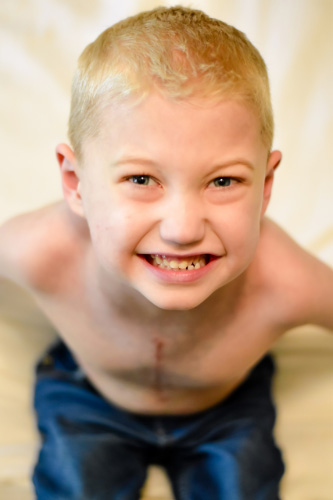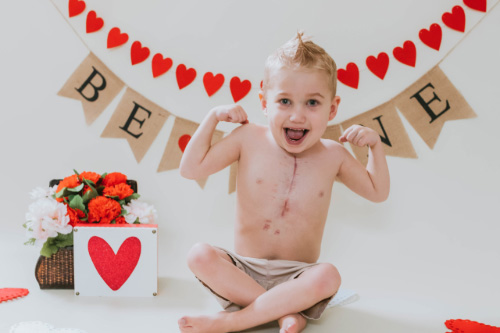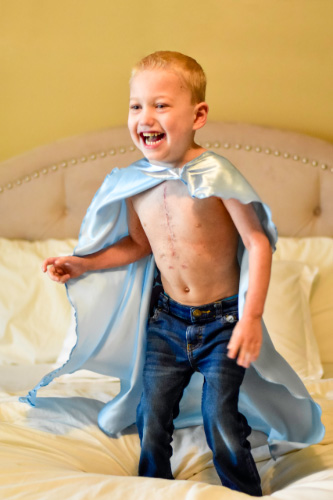
During her 20-week ultrasound, Savannah’s obstetrician diagnosed that her unborn baby’s heart was abnormally small and referred her to a maternal fetal medicine specialist. The specialist ordered a dedicated fetal echocardiogram (“echo”), a specialized ultrasound of the fetal heart, and referred Savannah to The Fetal Center at Children’s Memorial Hermann Hospital.
Diagnosis: Hypoplastic Left Heart
Savannah and her husband, David, made an appointment with an affiliated fetal cardiologist at The Fetal Center who reviewed the echo and confirmed the diagnosis. Savannah’s baby had a severe congenital (present at birth) heart defect, a hypoplastic (small) left heart. During her pregnancy, the left side of her baby’s heart did not form completely and therefore was not capable of supporting normal blood flow to the body and the brain. A child with this condition, which is fairly common, is not able to lead a normal life.
Using video animation, doctors affiliated with Children’s Memorial Hermann Hospital explained to Savannah and David that in a baby with this condition, most of the structures on the left side of the heart are too small and underdeveloped to enable the heart to effectively pump blood to meet the body’s needs. Major heart surgery would be required after birth to use the right side of the heart to pump red blood to the body.
Original Treatment Plan: Three Open Heart Surgeries
For the remainder of her pregnancy, Savannah was monitored by a comprehensive team of affiliated specialists from The Fetal Center and the Children’s Heart Institute at Children’s Memorial Hermann Hospital who created a treatment plan for Savannah and her baby. The baby would be delivered at Children’s Memorial Hermann Hospital and then placed in the hospital’s Level IV Neonatal Intensive Care Unit (NICU).
Savannah and David were told that after birth, their baby would require a series of three open heart surgeries, together known as the Fontan palliation sequence, to rearrange his heart to function with only a single working ventricle (functionally, half a heart). Although commonly accepted as the standard of care for hypoplastic left heart, the Fontan palliation sequence represents a compromise. With only the right ventricle pumping to their bodies, children undergoing these operations are not assured a length or quality of life. Often, they experience heart failure and require a transplant while still young.
The first procedure (Norwood procedure) would occur in the first week of the baby’s life followed by a second procedure (bidirectional Glenn) between four to six months of age. The final staged reconstruction would occur around 3 years of age, using the Fontan procedure.
Successful Norwood and Glenn Surgeries

Savannah and David’s son, Cason, was born at Children’s Memorial Hermann Hospital in August 2014 weighing 7 pounds, 10 ounces. When Cason was ten days old, the Norwood procedure was performed, which was a success, and after a two-week stay, he went home. Six months later, he underwent the second surgery, the bidirectional Glenn, which was also a success.
Cason’s third surgery, the Fontan procedure, was to be performed in January 2018, when he was about 3½ years old. By this time, pediatric cardiac surgeon Jorge Salazar, MD, had joined the Children’s Heart Institute. Dr. Salazar is Co-director of the Children’s Heart Institute and Professor and Chief of Pediatric and Congenital Heart Surgery at McGovern Medical School at UT Health.
Prior to joining the Children’s Heart Institute, Dr. Salazar was part of a team pioneering an innovative procedure called a Biventricular Repair and Conversion, through which the surgeon rearranges the connections of the child’s heart, converting a heart with a single functioning ventricle into a normal heart with two functioning ventricles.
“After reviewing Cason’s imaging tests and treatment history, it was clear to me that Cason’s heart was already failing as a single ventricle heart. The blessing was that it appeared possible—as it is for many children—to perform this new procedure, a biventricular conversion. Unlike the Fontan, this would give him a normally functioning heart. We talked about it as a team, and we talked about it with the family. Although Cason’s treatment plan started many years ago, today, because of new advancements in medicine, we can often do something much better for the child; we can give the child a normal heart.”
The New Plan: Staged Left Ventricle Recruitment (SLVR)
Dr. Salazar approached Savannah and David and confirmed the good news. Cason’s left ventricle was present and could be recruited to work on its own. This meant that Cason was a candidate for biventricular conversion.
That day, instead of performing the planned Fontan, Dr. Salazar and his team performed a procedure to recruit and grow Cason’s left ventricle to support his body and brain, in anticipation of performing the final step—the biventricular conversion, to give him a normal heart.
Savannah recalls how Dr. Salazar helped put their minds at ease. “He called us the night before the surgery and spoke to us for a long time. He didn’t seem in any rush, answering all our questions. He gave us his cell number and encouraged us to call him anytime.”
Final Step: Full Conversion to a Normal Heart

To make sure Cason’s heart was ready for the biventricular conversion, an affiliated pediatric cardiologist tested Cason’s heart in the heart catheterization laboratory. As Dr. Salazar explains, “The pediatric cardiologist simulated what it would look like if the heart were completely repaired. Using a catheter and a balloon, the pediatric cardiologist measured all the cardiac pressures and resistances to prove that it would work. And it did.”
On January 16, 2019, Dr. Salazar performed the eight-hour biventricular conversion surgery at Children’s Memorial Hermann Hospital, completing the conversion of Cason’s heart to a normal heart, with the left ventricle working on its own to provide red blood to the body. Says Dr. Salazar, “Cason now has a normally functioning heart, and his prognosis for a long, healthy life is excellent. Had Cason stayed on his original path, the Fontan palliation sequence, he would likely have required a heart transplant within a year.”
Cason’s parents have noted a marked change in Cason since the surgery. “Before the last surgery, Cason’s blood oxygen levels were around 70-80%,” says Savannah. “He was always out of breath, always winded. I carried him everywhere. Since this last surgery, he is a new child. He’s refreshed and awake. He has so much energy, so much stamina.”
Cason is a normal boy with a normal heart.
"The right place at the right time"
Savannah and David are grateful that Dr. Salazar was there to care for Cason. “We were there at the right time, at the right place,” says Savannah. “If Dr. Salazar hadn’t been there, we would have had to go a different route. Maybe we would have gone through with the Fontan that day. Dr. Salazar gave us new hope. He is amazing. A true miracle. When we got the diagnosis, we envisioned a lifetime of limited activity, medications, maybe even a heart transplant. This new procedure gave Cason life. It is the greatest gift, ever.”
The Children’s Heart Institute is currently one of only a handful of centers in the world offering biventricular repairs and conversions as part of a comprehensive Biventricular Repair Program. “There are thousands of kids with failing single ventricles who can be treated with this new, lifesaving procedure. And even kids who are not candidates for the full biventricular conversion should be re-evaluated. There are many procedures we can perform to improve their quality and length of life. We just need to look at these kids with an open mind,” says Dr. Salazar.
Contact Us
To contact Children’s Heart Institute at Children’s Memorial Hermann Hospital, please fill out the form below.
The Children’s Heart Institute is a collaboration between the affiliated physicians at McGovern Medical School at UTHealth Houston and Children’s Memorial Hermann Hospital. Typically, patients are seen on an outpatient basis at a UT Physicians clinic with all inpatient procedures performed at Children’s Memorial Hermann Hospital.